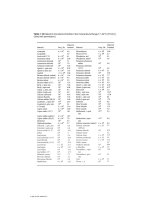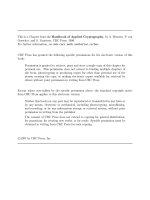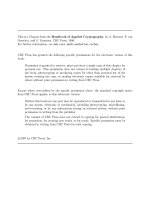Handbook of biodegradable Polymers
Bạn đang xem bản rút gọn của tài liệu. Xem và tải ngay bản đầy đủ của tài liệu tại đây (3.39 MB, 426 trang )
Edited by
Andreas Lendlein and
Adam Sisson
Handbook of
Biodegradable Polymers
Further Reading
Loos, K. (Ed.)
Biocatalysis in Polymer
Chemistry
2011
Hardcover
ISBN: 978-3-527-32618-1
Matyjaszewski, K.,
Müller, A. H. E. (Eds.)
Controlled and Living
Polymerizations
From Mechanisms to Applications
2009
ISBN: 978-3-527-32492-7
Mathers, R. T., Maier, M. A. R. (Eds.)
Green Polymerization
Methods
Renewable Starting Materials, Catalysis
and Waste Reduction
2011
Hardcover
ISBN: 978-3-527-32625-9
Matyjaszewski, K., Gnanou, Y.,
Leibler, L. (Eds.)
Macromolecular Engineering
Precise Synthesis, Materials Properties,
Applications
2007
Hardcover
ISBN: 978-3-527-31446-1
Yu, L.
Biodegradable Polymer Blends
and Composites from
Renewable Resources
Fessner, W.-D., Anthonsen, T. (Eds.)
Modern Biocatalysis
Stereoselective and Environmentally
Friendly Reactions
2009
Hardcover
ISBN: 978-0-470-14683-5
2009
ISBN: 978-3-527-32071-4
Elias, H.-G.
Janssen, L., Moscicki, L. (Eds.)
Macromolecules
Thermoplastic Starch
2009
Hardcover
ISBN: 978-3-527-31171-2
A Green Material for Various Industries
2009
Hardcover
ISBN: 978-3-527-32528-3
Edited by Andreas Lendlein and Adam Sisson
Handbook of Biodegradable Polymers
Synthesis, Characterization and Applications
The Editors
Prof. Andreas Lendlein
GKSS Forschungszentrum
Inst. für Chemie
Kantstr. 55
14513 Teltow
Germany
All books published by Wiley-VCH are carefully
produced. Nevertheless, authors, editors, and
publisher do not warrant the information contained
in these books, including this book, to be free of
errors. Readers are advised to keep in mind that
statements, data, illustrations, procedural details or
other items may inadvertently be inaccurate.
Library of Congress Card No.: applied for
Dr. Adam Sisson
GKSS Forschungszentrum
Zentrum f. Biomaterialentw.
Kantstraße 55
14513 Teltow
Germany
British Library Cataloguing-in-Publication Data
A catalogue record for this book is available from
the British Library.
Bibliographic information published by
the Deutsche Nationalbibliothek
The Deutsche Nationalbibliothek lists this
publication in the Deutsche Nationalbibliografie;
detailed bibliographic data are available on the
Internet at < >.
© 2011 Wiley-VCH Verlag & Co. KGaA,
Boschstr. 12, 69469 Weinheim, Germany
All rights reserved (including those of translation
into other languages). No part of this book may be
reproduced in any form – by photoprinting,
microfilm, or any other means – nor transmitted or
translated into a machine language without written
permission from the publishers. Registered names,
trademarks, etc. used in this book, even when not
specifically marked as such, are not to be
considered unprotected by law.
Cover Design Grafik-Design Schulz, Fgưnheim
Typesetting Toppan Best-set Premedia Limited,
Hong Kong
Printing and Binding Fabulous Printers Pte Ltd,
Singapore
Printed in Singapore
Printed on acid-free paper
ISBN: 978-3-527-32441-5
ePDF ISBN: 978-3-527-63583-2
ePub ISBN: 978-3-527-63582-5
Mobi ISBN: 978-3-527-63584-9
oBook ISBN: 978-3-527-63581-8
V
Contents
Preface XV
List of Contributors XVII
1
1.1
1.1.1
1.1.2
1.2
1.2.1
1.2.2
1.2.3
1.3
1.3.1
1.3.2
1.3.3
1.3.4
1.4
1.4.1
1.4.2
1.5
1.5.1
1.5.2
1.5.3
2
2.1
2.2
2.3
2.4
Polyesters 1
Adam L. Sisson, Michael Schroeter, and Andreas Lendlein
Historical Background 1
Biomedical Applications 1
Poly(Hydroxycarboxylic Acids) 2
Preparative Methods 3
Poly(Hydroxycarboxylic Acid) Syntheses 3
Metal-Free Synthetic Processes 6
Polyanhydrides 6
Physical Properties 7
Crystallinity and Thermal Transition Temperatures 7
Improving Elasticity by Preparing Multiblock Copolymers
Covalently Crosslinked Polyesters 11
Networks with Shape-Memory Capability 11
Degradation Mechanisms 12
Determining Erosion Kinetics 12
Factors Affecting Erosion Kinetics 13
Beyond Classical Poly(Hydroxycarboxylic Acids) 14
Alternate Systems 14
Complex Architectures 15
Nanofabrication 16
References 17
9
Biotechnologically Produced Biodegradable Polyesters 23
Jaciane Lutz Ienczak and Gláucia Maria Falcão de Aragão
Introduction 23
History 24
Polyhydroxyalkanoates – Granules Morphology 26
Biosynthesis and Biodegradability of Poly(3-Hydroxybutyrate) and
Other Polyhydroxyalkanoates 29
VI
Contents
2.4.1
2.4.2
2.4.3
2.5
2.6
2.7
3
3.1
3.2
3.2.1
3.2.2
3.2.3
3.2.4
3.2.5
3.2.6
3.2.7
3.2.8
3.2.9
3.2.10
3.3
3.4
3.5
3.6
3.7
3.8
3.9
3.10
4
4.1
4.2
4.2.1
4.2.1.1
4.2.1.2
4.2.1.3
4.2.2
4.2.2.1
4.2.2.2
Polyhydroxyalkanoates Biosynthesis on Microorganisms
Plants as Polyhydroxyalkanoates Producers 32
Microbial Degradation of Polyhydroxyalkanoates 33
Extraction and Recovery 34
Physical, Mechanical, and Thermal Properties of
Polyhydroxyalkanoates 36
Future Directions 37
References 38
29
Polyanhydrides 45
Avi Domb, Jay Prakash Jain, and Neeraj Kumar
Introduction 45
Types of Polyanhydride 46
Aromatic Polyanhydrides 46
Aliphatic–Aromatic Polyanhydrides 49
Poly(Ester-Anhydrides) and Poly(Ether-Anhydrides) 49
Fatty Acid-Based Polyanhydrides 49
RA-Based Polyanhydrides 49
Amino Acid-Based Polyanhydrides 51
Photopolymerizable Polyanhydrides 52
Salicylate-Based Polyanhydrides 53
Succinic Acid-Based Polyanhydrides 54
Blends 55
Synthesis 55
Properties 58
In Vitro Degradation and Erosion of Polyanhydrides 63
In Vivo Degradation and Elimination of Polyanhydrides 64
Toxicological Aspects of Polyanhydrides 65
Fabrication of Delivery Systems 67
Production and World Market 68
Biomedical Applications 68
References 71
Poly(Ortho Esters) 77
Jorge Heller
Introduction 77
POE II 79
Polymer Synthesis 79
Rearrangement Procedure Using an Ru(PPh3)3Cl2 Na2CO3
Catalyst 80
Alternate Diketene Acetals 80
Typical Polymer Synthesis Procedure 80
Drug Delivery 81
Development of Ivermectin Containing Strands to Prevent Heartworm
Infestation in Dogs 81
Experimental Procedure 81
Contents
4.2.2.3
4.3
4.3.1
4.3.1.1
4.3.1.2
4.3.1.3
4.3.2
4.4
4.4.1
4.4.2
4.4.3
4.4.4
4.4.5
4.4.5.1
4.4.5.2
4.4.6
4.4.6.1
4.4.6.2
4.4.7
4.5
4.5.1
4.5.2
4.5.3
4.5.3.1
4.5.3.2
4.5.4
4.5.4.1
4.5.4.2
4.5.5
4.5.6
4.5.6.1
4.5.6.2
4.5.6.3
4.5.6.4
4.6
4.7
Results 82
POE IV 82
Polymer Synthesis 82
Typical Polymer Synthesis Procedure 82
Latent Acid 83
Experimental Procedure 83
Mechanical Properties 83
Solid Polymers 86
Fabrication 86
Polymer Storage Stability 87
Polymer Sterilization 87
Polymer Hydrolysis 88
Drug Delivery 91
Release of Bovine Serum Albumin from Extruded Strands 91
Experimental Procedure 93
Delivery of DNA Plasmid 93
DNA Plasmid Stability 94
Microencapsulation Procedure 94
Delivery of 5-Fluorouracil 95
Gel-Like Materials 96
Polymer Molecular Weight Control 96
Polymer Stability 98
Drug Delivery 99
Development of APF 112 Mepivacaine Delivery System 99
Formulation Used 99
Preclinical Toxicology 100
Polymer Hydrolysate 100
Wound Instillation 100
Phase II Clinical Trial 100
Development of APF 530 Granisetron Delivery System 100
Preclinical Toxicology 100
Rat Study 101
Dog Study 101
Phase II and Phase III Clinical Trials 101
Polymers Based on an Alternate Diketene Acetal 102
Conclusions 104
References 104
5
Biodegradable Polymers Composed of Naturally Occurring
α-Amino Acids 107
Ramaz Katsarava and Zaza Gomurashvili
Introduction 107
Amino Acid-Based Biodegradable Polymers (AABBPs) 109
Monomers for Synthesizing AABBPs 109
Key Bis-Nucleophilic Monomers 109
Bis-Electrophiles 111
5.1
5.2
5.2.1
5.2.1.1
5.2.1.2
VII
VIII
Contents
5.2.2
5.2.3
5.2.3.1
5.2.3.2
5.2.3.3
5.2.3.4
5.2.4
5.2.4.1
5.2.4.2
5.2.4.3
5.2.5
5.2.6
5.3
AABBPs’ Synthesis Methods 111
AABBPs: Synthesis, Structure, and Transformations 115
Poly(ester amide)s 115
Poly(ester urethane)s 119
Poly(ester urea)s 119
Transformation of AABBPs 119
Properties of AABBPs 121
MWs, Thermal, Mechanical Properties, and Solubility 121
Biodegradation of AABBPs 121
Biocompatibility of AABBPs 123
Some Applications of AABBPs 124
AABBPs versus Biodegradable Polyesters 125
Conclusion and Perspectives 126
References 127
6
Biodegradable Polyurethanes and Poly(ester amide)s 133
Alfonso Rodríguez-Galán, Lourdes Franco, and Jordi Puiggalí
Abbreviations 133
Chemistry and Properties of Biodegradable Polyurethanes 134
Biodegradation Mechanisms of Polyurethanes 140
Applications of Biodegradable Polyurethanes 142
Scaffolds 142
Cardiovascular Applications 143
Musculoskeletal Applications 143
Neurological Applications 144
Drug Delivery Systems 144
Other Biomedical Applications 145
New Polymerization Trends to Obtain Degradable Polyurethanes 145
Polyurethanes Obtained without Using Diisocynates 145
Enzymatic Synthesis of Polyurethanes 146
Polyurethanes from Vegetable Oils 147
Polyurethanes from Sugars 147
Aliphatic Poly(ester amide)s: A Family of Biodegradable
Thermoplastics with Interest as New Biomaterials 149
Acknowledgments 152
References 152
6.1
6.2
6.3
6.3.1
6.3.1.1
6.3.1.2
6.3.1.3
6.3.2
6.3.3
6.4
6.4.1
6.4.2
6.4.3
6.4.4
6.5
7
7.1
7.2
7.3
7.4
7.5
7.6
Carbohydrates 155
Gerald Dräger, Andreas Krause, Lena Möller, and Severian Dumitriu
Introduction 155
Alginate 156
Carrageenan 160
Cellulose and Its Derivatives 162
Microbial Cellulose 164
Chitin and Chitosan 165
Contents
7.7
7.8
7.9
7.10
7.11
7.12
7.13
7.14
Dextran 169
Gellan 171
Guar Gum 174
Hyaluronic Acid (Hyaluronan) 176
Pullulan 180
Scleroglucan 182
Xanthan 184
Summary 186
Acknowledgments 187
In Memoriam 187
References 187
8
Biodegradable Shape-Memory Polymers 195
Marc Behl, Jörg Zotzmann, Michael Schroeter, and Andreas Lendlein
Introduction 195
General Concept of SMPs 197
Classes of Degradable SMPs 201
Covalent Networks with Crystallizable Switching Domains,
Ttrans = Tm 202
Covalent Networks with Amorphous Switching Domains,
Ttrans = Tg 204
Physical Networks with Crystallizable Switching Domains,
Ttrans = Tm 205
Physical Networks with Amorphous Switching Domains,
Ttrans = Tg 208
Applications of Biodegradable SMPs 209
Surgery and Medical Devices 209
Drug Release Systems 210
References 212
8.1
8.2
8.3
8.3.1
8.3.2
8.3.3
8.3.4
8.4
8.4.1
8.4.2
9
9.1
9.1.1
9.1.2
9.1.3
9.1.4
9.2
9.2.1
9.2.1.1
9.2.1.2
9.2.2
9.2.2.1
Biodegradable Elastic Hydrogels for Tissue Expander Application 217
Thanh Huyen Tran, John Garner, Yourong Fu, Kinam Park, and
Kang Moo Huh
Introduction 217
Hydrogels 217
Elastic Hydrogels 217
History of Elastic Hydrogels as Biomaterials 218
Elasticity of Hydrogel for Tissue Application 219
Synthesis of Elastic Hydrogels 220
Chemical Elastic Hydrogels 220
Polymerization of Water-Soluble Monomers in the Presence of
Crosslinking Agents 220
Crosslinking of Water-Soluble Polymers 221
Physical Elastic Hydrogels 222
Formation of Physical Elastic Hydrogels via Hydrogen Bonding 222
IX
X
Contents
9.2.2.2
9.3
9.3.1
9.3.2
9.3.3
9.4
9.4.1
9.4.2
9.5
9.6
10
10.1
10.2
10.2.1
10.3
10.3.1
10.3.1.1
10.4
10.5
10.6
11
11.1
11.2
11.3
11.4
11.4.1
11.4.2
11.5
11.5.1
11.5.1.1
11.5.1.2
11.5.1.3
11.5.2
11.5.2.1
11.5.2.2
11.5.2.3
Formation of Physical Elastic Hydrogels via
Hydrophobic Interaction 224
Physical Properties of Elastic Hydrogels 225
Mechanical Property 225
Swelling Property 227
Degradation of Biodegradable Elastic Hydrogels 229
Applications of Elastic Hydrogels 229
Tissue Engineering Application 229
Application of Elastic Shape-Memory Hydrogels as Biodegradable
Sutures 230
Elastic Hydrogels for Tissue Expander Applications 231
Conclusion 233
References 234
Biodegradable Dendrimers and Dendritic Polymers 237
Jayant Khandare and Sanjay Kumar
Introduction 237
Challenges for Designing Biodegradable Dendrimers 240
Is Biodegradation a Critical Measure of Biocompatibility? 243
Design of Self-Immolative Biodegradable Dendrimers 245
Clevable Shells – Multivalent PEGylated Dendrimer for
Prolonged Circulation 246
Polylysine-Core Biodegradable Dendrimer Prodrug 250
Biological Implications of Biodegradable Dendrimers 256
Future Perspectives of Biodegradable Dendrimers 259
Concluding Remarks 259
References 260
Analytical Methods for Monitoring Biodegradation Processes
of Environmentally Degradable Polymers 263
Maarten van der Zee
Introduction 263
Some Background 263
Defining Biodegradability 265
Mechanisms of Polymer Degradation 266
Nonbiological Degradation of Polymers 266
Biological Degradation of Polymers 267
Measuring Biodegradation of Polymers 267
Enzyme Assays 269
Principle 269
Applications 269
Drawbacks 270
Plate Tests 270
Principle 270
Applications 270
Drawbacks 270
Contents
11.5.3
11.5.3.1
11.5.3.2
11.5.3.3
11.5.4
11.5.4.1
11.5.4.2
11.5.4.3
11.5.5
11.5.5.1
11.5.5.2
11.5.6
11.5.6.1
11.5.6.2
11.5.6.3
11.5.7
11.6
Respiration Tests 271
Principle 271
Applications 271
Suitability 271
Gas (CO2 or CH4) Evolution Tests 272
Principle 272
Applications 272
Suitability 273
Radioactively Labeled Polymers 273
Principle and Applications 273
Drawbacks 273
Laboratory-Scale Simulated Accelerating Environments
Principle 274
Applications 274
Drawbacks 275
Natural Environments, Field Trials 275
Conclusions 275
References 276
12
Modeling and Simulation of Microbial Depolymerization Processes
of Xenobiotic Polymers 283
Masaji Watanabe and Fusako Kawai
Introduction 283
Analysis of Exogenous Depolymerization 284
Modeling of Exogenous Depolymerization 284
Biodegradation of PEG 287
Materials and Methods 287
Chemicals 287
Microorganisms and Cultivation 287
HPLC analysis 288
Numerical Study of Exogenous Depolymerization 288
Time Factor of Degradation Rate 291
Simulation with Time-Dependent Degradation Rate 293
Analysis of Endogenous Depolymerization 295
Modeling of Endogenous Depolymerization 295
Analysis of Enzymatic PLA Depolymerization 300
Simulation of an Endogenous Depolymerization
Process of PLA 302
Discussion 306
Acknowledgments 307
References 307
12.1
12.2
12.2.1
12.2.2
12.3
12.3.1
12.3.2
12.3.3
12.3.4
12.3.5
12.3.6
12.4
12.4.1
12.4.2
12.4.3
12.5
13
274
Regenerative Medicine: Reconstruction of Tracheal and Pharyngeal
Mucosal Defects in Head and Neck Surgery 309
Dorothee Rickert, Bernhard Hiebl, Rosemarie Fuhrmann, Friedrich Jung,
Andreas Lendlein, and Ralf-Peter Franke
XI
XII
Contents
13.1
13.1.1
13.1.2
13.1.3
13.1.4
13.2
13.2.1
13.2.2
13.2.2.1
13.2.2.2
13.2.3
13.3
13.3.1
13.3.2
13.3.3
13.3.4
13.4
13.5
13.6
14
14.1
14.2
14.2.1
14.2.2
14.2.3
14.2.4
14.2.5
14.3
14.3.1
14.3.2
14.3.3
14.4
14.4.1
14.4.2
Introduction 309
History of Implant Materials 309
Regenerative Medicine 309
Functionalized Implant Materials 310
Sterilization of Polymer-Based Degradable
Implant Materials 310
Regenerative Medicine for the Reconstruction of the Upper
Aerodigestive Tract 311
Applications of Different Implant Materials in
Tracheal Surgery 312
New Methods and Approaches for Tracheal
Reconstruction 313
Epithelialization of Tracheal Scaffolds 317
Vascular Supply of Tracheal Constructs 319
Regenerative Medicine for Reconstruction of
Pharyngeal Defects 320
Methods and Novel Therapeutical Options in Head and
Neck Surgery 321
Primary Cell Cultures of the Upper Aerodigestive Tract 321
Assessment and Regulation of Matrix Metalloproteases and Wound
Healing 321
Influence of Implant Topography 322
Application of New Implant Materials in Animal Models 324
Vascularization of Tissue-Engineered Constructs 328
Application of Stem Cells in Regenerative Medicine 329
Conclusion 331
References 331
Biodegradable Polymers as Scaffolds for Tissue Engineering
Yoshito Ikada
Abbreviations 341
Introduction 341
Short Overview of Regenerative Biology 342
Limb Regeneration of Urodeles 342
Wound Repair and Morphogenesis in the Embryo 343
Regeneration in Human Fingertips 344
The Development of Bones: Osteogenesis 345
Regeneration in Liver: Compensatory Regeneration 347
Minimum Requirements for Tissue Engineering 348
Cells and Growth Factors 348
Favorable Environments for Tissue Regeneration 349
Need for Scaffolds 350
Structure of Scaffolds 352
Surface Structure 352
Porous Structure 353
341
Contents
14.4.3
14.4.4
14.5
14.5.1
14.5.2
14.5.3
14.6
14.6.1
14.6.2
14.6.3
14.6.4
14.7
Architecture of Scaffold 353
Barrier and Guidance Structure 354
Biodegradable Polymers for Tissue Engineering 354
Synthetic Polymers 355
Biopolymers 356
Calcium Phosphates 357
Some Examples for Clinical Application of Scaffold 357
Skin 357
Articular Cartilage 357
Mandible 358
Vascular Tissue 359
Conclusions 361
References 361
15
Drug Delivery Systems 363
Kevin M. Shakesheff
Introduction 363
The Clinical Need for Drug Delivery Systems 364
Poly(α-Hydroxyl Acids) 365
Controlling Degradation Rate 366
Polyanhydrides 368
Manufacturing Routes 370
Examples of Biodegradable Polymer Drug Delivery Systems
Under Development 371
Polyketals 371
Synthetic Fibrin 371
Nanoparticles 372
Microfabricated Devices 373
Polymer–Drug Conjugates 373
Responsive Polymers for Injectable Delivery 375
Peptide-Based Drug Delivery Systems 375
Concluding Remarks 376
References 376
15.1
15.2
15.3
15.3.1
15.4
15.5
15.6
15.6.1
15.6.2
15.6.3
15.6.4
15.6.5
15.6.6
15.6.7
15.7
16
16.1
16.2
16.3
16.3.1
16.3.2
16.3.3
16.4
16.4.1
Oxo-biodegradable Polymers: Present Status and
Future Perspectives 379
Emo Chiellini, Andrea Corti, Salvatore D’Antone, and David Mckeen Wiles
Introduction 379
Controlled – Lifetime Plastics 380
The Abiotic Oxidation of Polyolefins 382
Mechanisms 383
Oxidation Products 384
Prodegradant Effects 386
Enhanced Oxo-biodegradation of Polyolefins 387
Biodegradation of Polyolefin Oxidation Products 390
XIII
XIV
Contents
16.4.2
16.4.3
16.5
16.6
Standard Tests 391
Biometric Measurements 393
Processability and Recovery of Oxo-biodegradable Polyolefins
Concluding Remarks 396
References 397
Index
399
395
XV
Preface
Degradable polyesters with valuable material properties were pioneered by
Carothers at DuPont by utilizing ring-opening polymerization approaches for
achieving high molecular weight aliphatic poly(lactic acid)s in the 1930s. As a
result of various oil crises, biotechnologically produced poly(hydroxy alkanoates)
were keenly investigated as greener, non-fossil fuel based alternatives to petrochemical based commodity plastics from the 1960s onwards. Shortly afterwards,
the first copolyesters were utilized as slowly drug releasing matrices and surgical
sutures in the medical field. In the latter half of the 20th century, biodegradable
polymers developed into a core field involving different scientific disciplines such
that these materials are now an integral part of our everyday lives. This field still
remains a hotbed of innovation today. There is a burning interest in the use of
biodegradable materials in clinical settings. Perusal of the literature will quickly
reveal that such materials are the backbone of modern, biomaterial-based
approaches in regenerative medicine. Equally, this technology is central to current
drug delivery research through biodegradable nanocarriers, microparticles, and
erodible implants, which enable sophisticated controlled drug release and targeting. Due to the long historic legacy of polymer research, this field has been able
to develop to a point where material compositions and properties can be refined
to meet desired, complex requirements. This enables the creation of a highly
versatile set of materials as a key component of new technologies. This collected
series of texts, written by experts, has been put together to showcase the state of
the art in this ever-evolving area of science.
The chapters have been divided into three groups with different themes.
Chapters 1–8 introduce specific materials and cover the major classes of polymers
that are currently explored or utilized. Chapters 9–14 describe applications of
biodegradable polymers, emphasizing the exciting potential of these materials. In
the final chapters, 15–16, characterization methods and modelling techniques of
biodegradation processes are depicted.
Materials: Lendlein et al., then Ienczak and Aragão, start with up-to-date reviews
of the seminal polyesters and biotechnologically produced polyesters, respectively.
Other chapters concern polymers with different scission moieties and behaviors.
Domb et al. provide a comprehensive review of polyanhydrides, which is followed
by an excellent overview of poly(ortho esters) contributed by Heller. Amino
XVI
Preface
acid- based materials and degradable polyurethanes make up the subject of the
next two chapters by Katsarava and Gomurashvili, then Puiggali et al., respectively.
Synthetic polysaccharides, which are related to many naturally occurring biopolymers, are then described at length by Dumitriu, Dräger et al. To conclude the
individual polymer-class section, biodegradable polyolefins, which are degraded
oxidatively, and are intended as degradable commodity plastics, are covered by
Wiles et al.
Applications: The two chapters by Ikada and Shakesheff give a critical update on
the status of biodegradable materials applied in regenerative therapy and then in
drug delivery systems. From there, further exciting applications are described;
shape-memory polymers and their potential as implant materials in minimally
invasive surgery are discussed by Lendlein et al.; Huh et al. highlight the importance of biodegradable hydrogels for tissue expander applications; Franke et al.
cover how implants can be used to aid regenerative treatment of mucosal defects
in surgery; Khandare and Kumar review the relevance of biodegradable dendrimers and dendritic polymers to the medical field.
Methods: Van der Zee gives a description of the methods used to quantify biodegradability and the implications of biodegradability as a whole; Watanabe and
Kawai go on to explain methods used to explore degradation through modelling
and simulations.
The aim of this handbook is to provide a reference guide for anyone practising
in the exploration or use of biodegradable materials. At the same time, each
chapter can be regarded as a stand alone work, which should be of great benefit
to readers interested in each specific field. Synthetic considerations, physical properties, and erosion behaviours for each of the major classes of materials are discussed. Likewise, the most up to date innovations and applications are covered in
depth. It is possible upon delving into the provided information to really gain a
comprehensive understanding of the importance and development of this field
into what it is today and what it can become in the future.
We wish to thank all of the participating authors for their excellent contributions
towards such a comprehensive work. We would particularly like to pay tribute to
two very special authors who sadly passed away during the production time of
this handbook. Jorge Heller was a giant in the biomaterials field and pioneered
the field of poly(ortho esters). Severian Dimitriu is well known for his series of
books on biodegradable materials, which served to inspire and educate countless
scientists in this area. Our sincerest thanks go to Gloria Heller and Daniela
Dumitriu for their cooperation in completing these chapters. We also acknowledge
the untiring administrative support of Karolin Schmälzlin, Sabine Benner and
Michael Schroeter, and the expert cooperation from the publishers at Wiley, especially Elke Maase and Heike Nöthe.
Teltow, September 2010
Andreas Lendlein
Adam Sisson
XVII
List of Contributors
Gláucia Maria Falcão de Aragão
Federal University of Santa Catarina
Chemical and Food Engineering
Department
Florianópolis, SC 88040-900
Brazil
Salvatore D’Antone
University of Pisa
Department of Chemistry and
Industrial Chemistry
via Risorgimento 35
Pisa 56126
Italy
Marc Behl
Center for Biomaterial Development,
Institute of Polymer Research
Helmholtz-Zentrum Geesthacht
Kantstr. 55
14513 Teltow
Germany
Avi Domb
Hebrew University
School of Pharmacy
Department of Medicinal Chemistry
Jerusalem 91120
Israel
Emo Chiellini
University of Pisa
Department of Chemistry and
Industrial Chemistry
via Risorgimento 35
Pisa 56126
Italy
Gerald Dräger
Gottfried Wilhelm Leibniz Universität
Hannover
Institut für Organische Chemie
Schneiderberg 1B
30167 Hannover
Germany
Andrea Corti
University of Pisa
Department of Chemistry and
Industrial Chemistry
via Risorgimento 35
Pisa 56126
Italy
Severian Dumitriut
University of Sherbrooke
Department of Chemical Engineering
2400 Boulevard de l′Université
Sherbrooke, Quebec J1K 2R1
Canada
XVIII
List of Contributors
Lourdes Franco
Universitat Politècnica de Catalunya
Departament d’Enginyeria Química
Av. Diagonal 647
08028 Barcelona
Spain
Ralf-Peter Franke
Centre for Biomaterial Development
and Berlin-Brandenburg Centre for
Regenerative Therapies (BCRT)
Institute of Polymer Research
Helmholtz-Zentrum Geesthacht
GmbH
Kantstr. 55
14513 Teltow
Germany
and
University of Ulm
Central Institute for Biomedical
Engineering
Department of Biomaterials
89069 Ulm
Germany
Yourong Fu
Akina, Inc.
West Lafayette, IN 47906
USA
Rosemarie Fuhrmann
University of Ulm
Central Institute for Biomedical
Engineering
Department of Biomaterials
89069 Ulm
Germany
John Garner
Akina, Inc.
West Lafayette, IN 47906
USA
Zaza Gomurashvili
PEA Technologies
709 Mockingbird Cr.
Escondido, CA 92025
USA
Jorge Hellert
PO Box 3519, Ashland, OR 97520
USA
Bernhard Hiebl
Centre for Biomaterial Development
and Berlin-Brandenburg Centre for
Regenerative Therapies (BCRT)
Institute of Polymer Research
Helmholtz-Zentrum Geesthacht
Kantstr. 55
14513 Teltow
Germany
Kang Moo Huh
Chungnam National University
Department of Polymer Science and
Engineering
Daejeon 305-764
South Korea
Jaciane Lutz Ienczak
Federal University of Santa Catarina
Chemical and Food Engineering
Department
Florianópolis, SC 88040-900
Brazil
Yoshito Ikada
Nara Medical University
Shijo-cho 840
Kashihara-shi
Nara 634-8521
Japan
List of Contributors
Jay Prakash Jain
National Institute of Pharmaceutical
Education and Research (NIPER)
Department of Pharmaceutics
Sector 67
S.A.S. Nagar (Mohali) 160062
India
Jayant Khandare
Piramal Life Sciences Ltd.
Polymer Chem. Grp
1 Nirlon Complex
Off Western Express Highway
Goregaon (E), Mumbai 400063
India
Friedrich Jung
Centre for Biomaterial Development
and Berlin-Brandenburg Centre for
Regenerative Therapies (BCRT)
Institute of Polymer Research
Helmholtz-Zentrum Geesthacht
Kantstr. 55
14513 Teltow
Germany
Andreas Krause
Gottfried Wilhelm Leibniz Universität
Hannover
Institut für Organische Chemie
Schneiderberg 1B
30167 Hannover
Germany
Ramaz Katsarava
Iv. Javakhishvili Tbilisi State
University
Institute of Medical Polymers and
Materials
1, Chavchavadze ave.
Tbilisi 0179
Georgia
and
Georgian Technical University
Centre for Medical Polymers and
Biomaterials
77, Kostava str.
Tbilisi 75
Georgia
Fusako Kawai
Kyoto Institute of Technology
Center for Nanomaterials and Devices
Matsugasaki
Sakyo-ku, Kyoto 606-8585
Japan
Neeraj Kumar
National Institute of Pharmaceutical
Education and Research (NIPER)
Department of Pharmaceutics
Sector 67
S.A.S. Nagar (Mohali) 160062
India
Sanjay Kumar
Piramal Life Sciences Ltd.
Polymer Chem. Grp
1 Nirlon Complex
Off Western Express Highway
Goregaon (E), Mumbai 400063
India
Andreas Lendlein
Center for Biomaterial Development
and Berlin-Brandenburg Center for
Regenerative Therapies, Institute of
Polymer Research
Helmholtz-Zemtrum Geesthacht
Kantstr. 55
14513 Teltow
Germany
XIX
XX
List of Contributors
Lena Möller
Gottfried Wilhelm Leibniz Universität
Hannover
Institut für Organische Chemie
Schneiderberg 1B
30167 Hannover
Germany
Kinam Park
Purdue University
Department of Biomedical
Engineering and Pharmaceutics
West Lafayette, IN 47907-2032
USA
Jordi Puiggalí
Universitat Politècnica de Catalunya
Departament d’Enginyeria Química
Av. Diagonal 647
08028 Barcelona
Spain
Dorothee Rickert
Marienhospital Stuttgart
Bưheimstrasse 37
70199 Stuttgart
Germany
Alfonso Rodríguez-Galán
Universitat Politècnica de Catalunya
Departament d’Enginyeria Qmica
Av. Diagonal 647
08028 Barcelona
Spain
Michael Schroeter
Center for Biomaterial Development
Institute of Polymer Research
Helmholtz-Zentrum Geesthacht
Kantstr. 55
14513 Teltow
Germany
Kevin M. Shakesheff
The University of Nottingham
School of Pharmacy, STEM
NG 7 2RD
UK
Adam L. Sisson
Center for Biomaterial Development
and Berlin-Brandenburg Center for
Regenerative Therapies, Institute of
Polymer Research
Helmholtz-Zentrum Geesthacht
Kantstr. 55
14513 Teltow
Germany
Thanh Huyen Tran
Chungnam National University
Department of Polymer Science and
Engineering
Daejeon 305-764
South Korea
Masaji Watanabe
Okayama University
Graduate School of Environmental
Science
1-1, Naka 3-chome
Tsushima, Okayama 700-8530
Japan
David Mckeen Wiles
Plastichem Consulting
Victoria, BC V8N 5W9
Canada
Maarten van der Zee
Wageningen UR
Food & Biobased Research
P.O. Box 17
6700 AA Wageningen
The Netherlands
Jörg Zotzmann
Center for Biomaterial Development
Institute of Polymer Research
Helmholtz-Zentrum Geesthacht
Kantstr. 55
14513 Teltow
Germany
1
1
Polyesters
Adam L. Sisson, Michael Schroeter, and Andreas Lendlein
1.1
Historical Background
1.1.1
Biomedical Applications
Biomaterials are defined as any materials intended to interface with biological
systems to analyze, treat, or replace any tissue, organ, or function of the body [1].
The current trend in biomaterial development is shifted toward the use of biodegradable materials that have definite advantages in the fields of tissue engineering
[2] and drug delivery [3]. The general principle is to use a material that achieves a
specific therapeutic task and is subsequently, over time, degraded and removed
harmlessly from the body. As an increasingly relevant part of the medical device
and controlled release industry, biodegradable polymers are used to fabricate
temporary scaffolds for tissue regeneration, medical sutures, and nano- or microscale drug delivery vehicles [4–6].
The important properties that are required for biodegradable biomaterials can
be summarized as follows:
•
•
•
•
•
Nontoxic and endotoxin-free, aiming to minimalize unwanted foreign body
responses upon implantation.
Degradation time should be matched to the regeneration or required therapy
time.
Mechanical properties must be suited to the required task.
Degradation products should be nontoxic and readily cleared from the body.
Material must be easily processed to allow tailoring for the required task.
Although natural polymers such as collagen have been used in medical applications throughout history, synthetic polymers are valuable also, as they allow us to
tailor properties such as mechanical strength and erosion behavior. Naturally
Handbook of Biodegradable Polymers: Synthesis, Characterization and Applications, First Edition. Edited by
Andreas Lendlein, Adam Sisson.
© 2011 Wiley-VCH Verlag GmbH & Co. KGaA. Published 2011 by Wiley-VCH Verlag GmbH & Co. KGaA.
2
1 Polyesters
occurring biopolymers are typically degraded by enzymatic means at a rate that
may be difficult to predict clinically. Furthermore, natural polymers may have
unwanted side effects arising from inherent biological activity. This has led to the
widespread use of biodegradable synthetic polymers in therapeutic applications.
Of this class, biodegradable aliphatic polyesters, which are degraded hydrolytically,
are by far the most employed.
1.1.2
Poly(Hydroxycarboxylic Acids)
All polyesters are, in principle, hydrolytically degradable. However, only (co)polyesters with short aliphatic chains between ester bonds typically degrade over the
time frame required for biomedical applications. The major group of this material
are the poly(hydroxycarboxylic acids), which are prepared via ring-opening polymerization of lactones or cyclic diesters. Indeed, the first biodegradable polyester
used as a medical suture in the 1960s was based on the polyglycolide. Scheme 1.1
shows the most common monomers and the polymers they produce. These
can be summarized as diglycolide, stereogenic dilactides, lactones such as εcaprolactone and stereogenic β-butyrolactone, the cyclic trimethylene carbonate,
and p-dioxanone. As the polymerization methods of these monomers are broadly
applicable to each, copolymers such as poly(lactide-co-glycolide) are readily
produced.
Another source of poly(hydroxycarboxylic acids) is from bacteria, which store
polyesters as their energy source [7]. These polymers are known as polyhydroxyalkanoates (PHAs) in the literature. The most common polymer derived from
bacteria is poly(3-hydroxybutyrate), which has the same structure as the polymer
which can be obtained from optically active β-butyrolactone [8]. Poly(3hydroxybutyrate) formed in this way is strictly stereoregular, showing the (R)
configuration. Biotechnologically produced polymers are discussed in more details
in Chapter 2 of this handbook.
Scheme 1.1 Common cyclic monomers for the preparation of polyester derivatives.
1.2 Preparative Methods
1.2
Preparative Methods
1.2.1
Poly(Hydroxycarboxylic Acid) Syntheses
Polyesters can be synthesized via the direct condensation of alcohols and acids.
This may take the form of condensing dialcohols and diacids, for example, AA +
BB systems, or the direct condensation of hydroxycaboxylic acid monomers, for
example, AB systems. Various catalysts and coupling reagents may be used but
typically the polyesters formed in this manner have low and uncontrolled molecular
weight and are not suitable for biomedical applications. The majority of cases
where a high degree of polymerization was obtained came via ring-opening polymerizations of cyclic monomers of the type shown in Scheme 1.1 [9]. The cyclic
dilactones are prepared from the corresponding hydroxycarboxylic acid by elimination of water in the presence of antimony catalysts such as Sb2O3 [10]. These dimers
have to be purified rigorously if high degrees of polymerization are sought, as
impurities such as water and residual hydroxycarboxylic acids can hinder polymerization. Enantiomerically pure lactic acids are typically produced by fermentation.
Ring-opening polymerizations may be initiated by nucleophiles, anionically,
cationically, or in the presence of coordinative catalysts. Representative mechanisms are shown in Scheme 1.2. However, precise mechanisms may vary from
case to case and are an ongoing important area of study [11, 12]. As a testament
to the popularity of the ring-opening polymerization approach, over 100 catalysts
were identified for the preparation of polylactide [13].
The typical complex used for the industrial preparation of polyglycolide derivatives is tin(II)-bis-(2-ethylhexanoate), also termed tin(II)octanoate. It is commercially available, easy to handle, and soluble in common organic solvents and in
melt monomers. High molecular weight polymers up to 106 Da and with narrow
polydispersities are obtained in a few hours in bulk at 140–220 °C. Approximately
0.02–0.05 wt% of catalyst is required. Care must be taken when polymerizing
dilactides, if stereochemistry is to be preserved. This means that milder conditions
are to be selected relative to the homopolymerization of diglycolide.
For the copolymerization of dilactide and diglycolide catalyzed with tin(II)
octoate, different reactivities are observed. A chain with a growing glycolide end
will add a further diglycolide with a preference of 3:1. With a terminal lactide unit,
the preference for diglycolide is 5:1. Due to this, glycolide blocks tend to form,
separated by single dilactides. One possibility to improve the homogeneity of
the composition of the obtained polyesters is the online control of the monomer
ratio by addition of further monomer. However, this method is technically
complicated.
The mechanism is a nonionic coordinated insertion mechanism, which is less
prone to the side reactions commonly found in ionic polymerizations, such as
transesterification or racemization [14, 15]. It has been found that the addition of
alcohols to the reaction mixture increases the efficiency of the tin catalyst albeit
3
4
1 Polyesters
i) Nucleophilic polymerization
O
O
+
Nu
O
Nu
O
O
O
O
O
−
O
+
Nu
dilactide
−
n
O
M
O
O
ii) Anionic polymerization
M
O
O
−
R–O
O
+
O
R
O
O
O
O
O
iii) Cationic polymerization
O
+
O
F3CSO3CH3 + O
O
−
M
O
dilactide
R
+
O
O
O
n
−
M
+
CH3
O
O
O
O
O
+
O
O
O
O
O
O
O
O
−
F3CSO3
O
O
CH3
O
O
iv) Coordination-insertion polymerization
RO AI
O
AI(OR)3
O
OR
OR
O
RO AI
RO
O
O
O
OR
O
O
O
O
O
O
O
O
O
O
RO
O
RO
O
H3O
n H
O
+
RO
O
O
dilactide
n AI(OR)2
RO
AI
O
O
m O
OR
O
O
O
O
Scheme 1.2 Overview of various mechanisms relevant to polylactide synthesis.
by a disputed mechanism [16]. Although tin(II)octoate has been accepted as a food
additive by the U.S. FDA, there are still concerns of using tin catalysts in biomedical applications.
Aluminum alkoxides have been investigated as replacement catalysts. The most
commonly used is aluminum isopropoxide, which has been largely used for mechanistic studies [17]. However, these are significantly less active than tin catalysts
requiring prolonged reaction times (several hours to days) and affording polymers
with molecular weights generally below 105 Da. There are also suspected links
between aluminum ions and Alzheimer’s disease. Zinc complexes, especially









